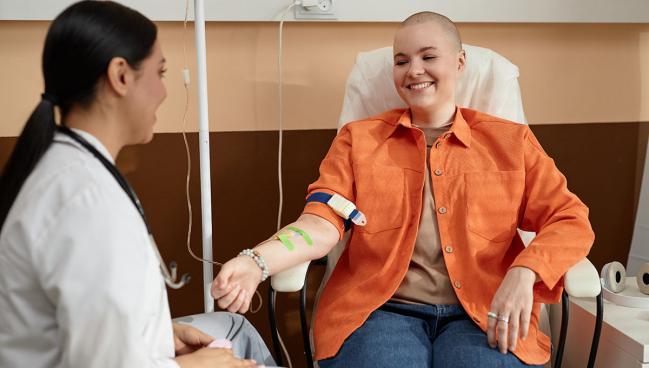CV Risk Modest for Most Cancer Survivors in Large Danish Registry
The results suggest toxicity may not be as pervasive as previously thought, which argues for more-personalized monitoring.

While the long-term risk of CVD in cancer survivors can vary significantly based on cancer type and treatment, the overall incidence may be lower than previously suspected, data from Danish population-based registries suggest.
Patients showed elevated risks of heart failure (HF) and cardiomyopathy related to treatment with anthracyclines, alkylating agents, and HER2-targeting agents, as other studies have shown, but they were no more likely to develop conditions like hypertension, stroke, or ischemic heart disease than cancer-free individuals in the general population.
The study authors, led by Frits I. Mulder, MD (Amsterdam University Medical Center, the Netherlands), say the analysis is timely in light of limited data on CV outcomes in cancer survivors and amid calls for more real-world observational evidence.
“Our findings may help raise awareness, support the identification of high-risk groups, and inform future guideline development,” Mulder and colleagues write. “Given the considerable variation in risk across subgroups, monitoring strategies should follow a personalized, risk-based approach.”
In the study, which defined survivors as those who were free of cancer and/or treatment 3 years after their diagnosis and began their follow-up from that point, Mulder and colleagues saw significant variation in 5-year CV risk across cancer types. Specifically, there was more HF, venous thromboembolism, pericarditis, endocarditis, myocarditis, and kidney failure in those with hematologic, lung, and prostate cancers rather than other types.
“One thing that is becoming clear is that when you talk about cardiovascular risk, it really matters what cancer you’re talking about,” noted Daniel Lenihan, MD (Saint Francis Healthcare System, Cape Girardeau, MO), who commented on the study for TCTMD. “For a patient with prostate cancer, we know that cardiovascular disease is the most likely way they will die because they have a slow-growing cancer. Will some of them die from prostate cancer? Sure. But they are much more likely to die because of the cardiovascular risk they may already have or CVD that may worsen during treatment.”
With significant improvement being made all the time in cancer therapies and patients surviving longer, Lenihan said understanding individual CV risk is important but also tricky.
In a recent US-based study of nearly 840,000 patients across nine cancer types, Lenihan and colleagues found more MACE and HF among patients with lung cancer, myeloma, and leukemia. Those with a history of lung cancer had a greater risk of stroke than patients with other cancer types.
While those associations can be helpful for CV risk-factor modification and follow-up for some patients, they don’t clarify the additional risk that the cancer adds for others, particularly younger people with highly treatable forms of cancer.
Lenihan added that although the Danish data are hypothesis-generating, the comparison of cancer survivors to people without cancer—in this case, five matches for every survivor—adds another layer of complexity to extrapolating the increased risk of CVD.
“This type of matching can yield arbitrary results that aren’t a clear reflection of one person’s risk compared with another person, even when they are matched well,” he added. “In the early cancer survivor data we saw that they often tried to match survivors with siblings, but even then, siblings are not going to have things like hypertension or diabetes at the same rate, so it’s not a perfect match no matter how you do it.”
Variations in Risks Seen
The study, published online June 17, 2025, in JACC: CardioOncology, compared 91,407 adult cancer survivors (mean age 67 years; 63% female) with 457,035 age- and sex-matched cancer-free individuals from the general population. Approximately 44% of patients had breast cancer, 15% prostate cancer, 13% colorectal cancer, and 11% hematological cancer. Smaller percentages of patients had gynecological, lung, urogenital, gastroesophageal, pancreatic, brain, melanoma, or hepatobiliary cancers.
Just over 60% of cancer survivors received some form of chemotherapy in the first 12 months after diagnosis: alkylating (21.8%), antimetabolites (16.8%), cytotoxic antibiotics (20.2%), plant alkyloids (24.8%), or platinum compounds (16.7%). Among those who received targeted therapies, half were treated with hormonal therapy.
At 5 years, ischemic heart disease was diagnosed in 3.24% of cancer survivors and 3.21% of controls (HR 0.96; 95% CI 0.91-1.01). By cancer type, only those with lung cancer had a higher rate of ischemic heart disease than their matched controls (HR 1.47; 95% CI 1.11-1.96). Ischemic heart disease was not elevated compared with controls in separate analyses of those who received chemotherapies or targeted therapies.
Rates of HF or cardiomyopathy at 5 years were 2.73% in survivors and 2.42% in controls (HR 1.08; 95% CI 1.02-1.15), with higher risks seen in those with hematological malignancies and prostate cancer. Chemotherapy increased the risk of HF or cardiomyopathy, particularly the use of podophyllotoxin derivatives, vinca alkaloids, and anthracyclines. Targeted therapies also were associated with increased risk, but hormonal therapies were not.
Venous thromboembolism was more frequent in cancer survivors than controls (2.02% vs 1.43%; HR 1.50; 95% CI 1.41-1.61) and was increased across all treatment groups and cancer types except GI cancer.
Acute or chronic kidney failure was seen in 2.36% of cancer survivors and 1.92% of controls (HR 1.17; 95% CI 1.10-1.25), with the greatest risks seen in those with hematological, lung, urogenital, and prostate cancer, as well as those who received chemotherapy or hormonal therapy.
Rates of atrial fibrillation or flutter were 4.59% in survivors and 4.42% in controls (HR 1.01; 95% CI 0.96-1.05), with increased risk seen in those with hematological cancer and those treated with targeted therapies.
In terms of other CV outcomes, cancer survivors were at greater risk of the composite of pericarditis, endocarditis, or myocarditis compared with controls (HR 1.30; 95% CI 1.11-1.52). No increased risks were seen for aortic aneurysm or dissection, valvular heart disease, or other cardiac arrhythmias.
When CV events occurred, they were often followed by relapse or a new primary cancer diagnosis. In subanalyses, the inclusion of patients with new or relapsed cancer was associated with increased risks of atrial fibrillation or flutter, venous thromboembolism, and kidney failure that were not seen when that group was excluded.
“Our study builds on previous research by providing more up-to-date estimates that are likely more relevant to cancer survivors who have completed systemic treatment and no longer have active cancer or ongoing therapy,” Mulder and colleagues write.
An Important Narrative for Patients
In an accompanying editorial, Nina Nouhravesh, MD, PhD, and Morten Schou, MD, PhD (both from Herlev-Gentofte University Hospital, Copenhagen, Denmark), note that the strengths of the associations seen in the study are modest and that “the consistency across multiple CV endpoints suggests a substantial role for unmeasured and residual confounding.” The use of registry data, they add, doesn’t capture several key clinical factors and could unintentionally generate signals that would otherwise be attenuated or nullified by adjustment for confounding.
“Survivors are not simply transitioning from one disease burden to another,” they add. “This is an important narrative, particularly for cancer patients who often report experiencing information overload, much of it anchored in alarming news.”
Nouhravesh and Schou also say findings challenge current thinking about universal CV screening for cancer survivors.
“Given the vast and growing size of the survivor population, such an approach is neither feasible nor likely justifiable. Instead, the data strongly support a more targeted strategy, indicating that a subset of patients is likely to benefit from structured surveillance programs,” they advise.
Mulder and colleagues say a personalized, risk-based approach to CVD prevention could potentially take the form of online risk calculators tailored to cancer survivors.
L.A. McKeown is a Senior Medical Journalist for TCTMD, the Section Editor of CV Team Forum, and Senior Medical…
Read Full BioSources
Mulder FI, Horváth-Puhó E, van Es N, et al. Risk of cardiovascular disease in cancer survivors after systemic treatment: a population-based cohort study. JACC CardioOncol. 2025;7:360-378.
Nouhravesh N, Schou M. Cardiovascular care after cancer: is it time to emphasize event-free survival rather than cardiovascular risk? JACC CardioOncol. 2025;7:379-381.
Disclosures
- The study was supported by a research grant from the Karen Elise Jensen Foundation.
- Mulder, Nouhravesh, Schou, and Lenihan report no relevant conflicts of interest.





Comments